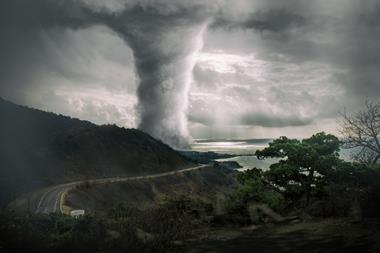Each year, the commercial catastrophe modelling companies review their software tools to incorporate the results of new research and data refinements based on actual experience. Recently, the changes in climate patterns necessitated updates to the core components of the models. In the United States, model vendors are also required to comply with new requirements from state governments, as well as rating and regulatory agencies.
Some of the key changes this year were made to the US hurricane and European windstorm models. In particular, all vendors implemented major modifications to their US hurricane models, and on average, underwriters might expect an increase of 40-50% in their average annual expected loss. The modifications are largely a result of the lessons learned from the hurricane activity of 2004 and 2005.
As catastrophe model output is a significant component of the process reinsurers use to price catastrophe reinsurance, these model changes have had a direct impact on the amount companies pay for their hurricane related coverage.
Because the most significant changes have taken place in the hurricane models, this article will focus on their impact, but we will also make some reference to changes in other perils and regions.
North American updates
US hurricane - frequency changes
The most anticipated model change this year was the introduction of a new view of hurricane frequency in the Atlantic Basin that explicitly represents risk over a near term, five year horizon. To develop this new view of risk, each modelling company engaged in careful review of scientific research and consulted with weather experts. From this research, the catastrophe modelling firms believe that they should represent hurricane risk over the next five years by landfalling activity rates that are higher than long term historical averages. This activity rate increase is primarily driven by the Atlantic Multidecadal Oscillation (AMO)1 phenomenon.
Additionally, the increases in frequency of category 3 to category 5 storms are greater than those less severe events. This change will cause companies to see increases in loss levels in the tail of probability distribution (more than 250 year return period losses).
The modellers still differ in opinion as to which event catalogue they should use going forward because of the uncertainty in climate changes. Guy Carpenter will run both the near term view, as well as continue to show the long term view to clients and reinsurers. Reinsurers are gravitating to the near term view for the pricing of catastrophe programmes, while the long term view is used for enterprise risk management and historical comparison purposes.
Vulnerability changes
Another notable improvement in the US hurricane models is for vulnerability. From research the modelling firms have conducted on claims data gathered from clients, they have determined that factors governing building codes play a more significant role in classifying vulnerability than previously considered. With the new versions of Risk Management Solutions (RMS) and AIR Worldwide Corporation models, the year of construction and the location of a structure are prominent in vulnerability curve selection, as is occupancy classification for commercial exposures.
While the overall increase in the modelled result for both models from vulnerability changes is only approximately 5%, these changes are more pronounced for commercial lines writers, leading to a more significant impact on reinsurers' evaluation of commercial risk and the primary underwriter's view of risk in the underwriting process.
For domestic property, the models have enhanced the build year for Florida risks by adding a band for new construction. This risk characteristic is now recognised as a driver of loss, versus the traditional view of the construction/occupancy combination.
For commercial lines writers, occupancy and year of construction will be the key drivers of loss. AIR has added several new occupancy types to reflect higher vulnerability of businesses such as fast food restaurants, auto repair shops, primary and secondary schools, petrol stations, aircraft hangers and golf courses. Finally, business interruption has increased for certain occupancies in RMS and AIR models. EQECAT did not change the vulnerability curves in its latest release, stating that the existing curves had correctly represented losses.
Performance
Many of the modelled loss estimates from 2004 and 2005 differed substantially from the actual claims. Non-modelled perils, such as economic factors and flooding, were a major component of the difference. Furthermore, much of the model storm surge methodology was outdated and did not account for recent experience. The updates will now include higher peak surge, more regional impact of terrain (for example, more trees in certain areas), enhanced modelling of bays and estuaries, and more variation on the effect of surge across construction and occupancy. We will see the largest impact for the Gulf region, driven by New Orleans.
Demand surge also formed a large part of the disparity in modelled versus actual results. In addressing demand surge beyond a limited impact from a single event, RMS will now consider a broader range of loss amplifying causes. Its definition of loss amplification reflects all those ways in which the costs incurred for a certain level of original damage increase within a major catastrophe. The components of loss amplification are as follows:
- Economic demand surge and repair delay inflation
- Claims inflation
- Super catastrophe effects
- Increased correlation for most severe events
This loss amplification change for RMS also affects other perils and regions.
Combining the impact of the various changes to the US hurricane models, we expect to see differences in the results ranging from a slight decrease to increases of over 200%, depending on the individual characteristics of the portfolio and the point on the loss curve being compared. Those portfolios increasing the least would likely be newer residential construction with certain types of commercial portfolios generating the largest increases.
Earthquake
Loss changes in the new earthquake models are less remarkable, although not insignificant. RMS modified its New Madrid and north eastern seismic zones models to account for low frequency of events. EQECAT also amended risk factors in its Pacific north west model.
Updates outside North America
As with the US hurricane model, RMS made significant changes to its European windstorm model based on new hazard, engineering and claims information. This included modifications to the event catalogue, hazard and vulnerability components. In general, the impact of these changes was not as significant as for US hurricane, but it varies by line of business and region. In the United Kingdom, we would expect a market portfolio of all lines results to decrease around 5% at the 100 year return period. In most regions, the impact was most severe for industrial portfolios.
Additional model releases and modifications this year in several countries including the following:
AIR has developed and released a detailed earthquake model in China with the analysis enabled at the six digit postcode.
EQECAT has increased capability by adding or updating earthquake models in Latin America, Europe and Japan and renewing its South Korean typhoon model to incorporate new hazard information and improved vulnerability functions. Flood is also included in this new version where the overall result is a decrease in loss at all return periods.
For Germany, we will soon receive a new release of EQECAT's German flood model, extended to include Austria, and a further flood model for the German market from RMS.
Summary
From a reinsurance industry perspective, the changes to the US hurricane models as well as the other peril changes exacerbate the continuing pressures from rating agencies and changing internal risk management guidelines. Ceding companies are seeking ways to buy more protection for the same level of exposure, and reinsurers need to mitigate the amount of exposure they will accept or allocate more capital as a result of increased losses generated by that exposure. For insurers to continue to mitigate these issues, they need to keep informed and well versed on how and why their portfolios perform in the new models, as well as have the analytical tools in place to evaluate business practices impacting specific areas of the portfolio.
Guy Carpenter has created a data management platform, i-aXs(TM) that gives companies the ability to access and analyse vast data instantly.
- Amy Block is senior vice president and Dickie Whitaker is managing director for Guy Carpenter. Email: Amy.Block@guycarp.com Email: Dickie.Whitaker@guycarp.com Website: www.guycarp.com


















